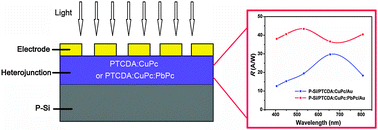Toward high performance broad spectral hybrid organic–inorganic photodetectors based on multiple component organic bulk heterojunctions†
Abstract
Broadening the absorption bandwidth of photodetectors by incorporating multiple absorber materials to form bulk-heterojunction active layers is an attractive method of resolving the narrow absorption of organic semiconductors. Here we report the fabrication and characterization of broad spectral hybrid organic–inorganic photodetectors through an optimized multiple component organic bulk heterojunctions route. The study clearly shows that both the two-component and three-component photodetectors have ultrahigh photosensitivity and spectral uniformity of responsivity for visible to near-infrared light. Operating at room temperature, the three-component based photodetectors achieve ultrahigh photosensitivities of 30–50 A W−1 at ∼0.1 mW incident optical power, which are almost two orders of magnitude larger than commercial Si and InGaAs photodiodes. Also, this work demonstrates that the wide variation of optical absorption of multiple component organic bulk heterojunctions will provide a strategy to fabricate facile broadband photodetectors.


 Please wait while we load your content...
Please wait while we load your content...